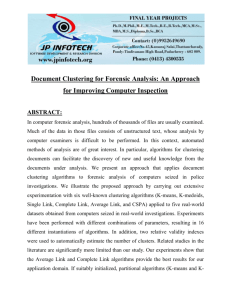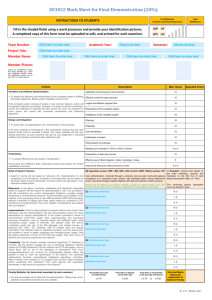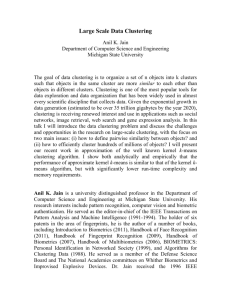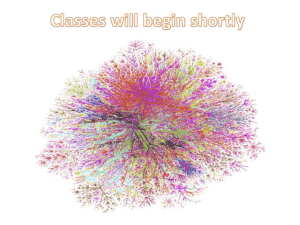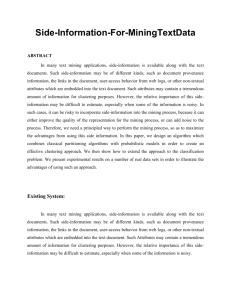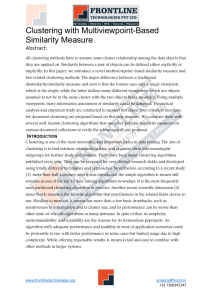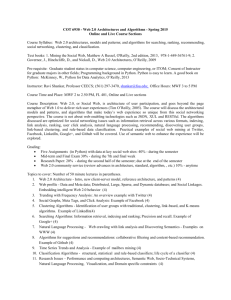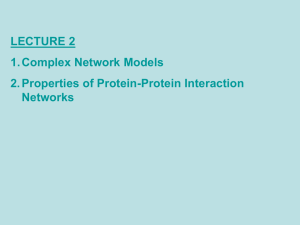Position Paper 2
advertisement
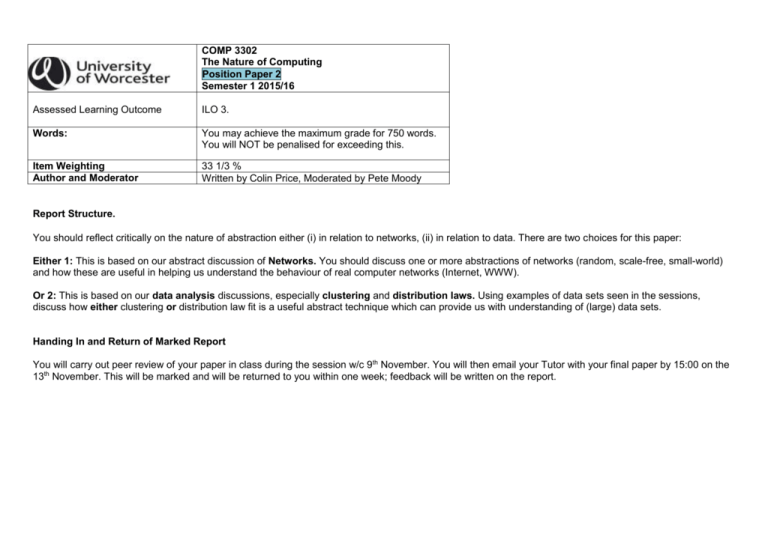
COMP 3302 The Nature of Computing Position Paper 2 Semester 1 2015/16 Assessed Learning Outcome ILO 3. Words: You may achieve the maximum grade for 750 words. You will NOT be penalised for exceeding this. Item Weighting Author and Moderator 33 1/3 % Written by Colin Price, Moderated by Pete Moody Report Structure. You should reflect critically on the nature of abstraction either (i) in relation to networks, (ii) in relation to data. There are two choices for this paper: Either 1: This is based on our abstract discussion of Networks. You should discuss one or more abstractions of networks (random, scale-free, small-world) and how these are useful in helping us understand the behaviour of real computer networks (Internet, WWW). Or 2: This is based on our data analysis discussions, especially clustering and distribution laws. Using examples of data sets seen in the sessions, discuss how either clustering or distribution law fit is a useful abstract technique which can provide us with understanding of (large) data sets. Handing In and Return of Marked Report You will carry out peer review of your paper in class during the session w/c 9th November. You will then email your Tutor with your final paper by 15:00 on the 13th November. This will be marked and will be returned to you within one week; feedback will be written on the report. Grading Matrix Template This matrix captures the assessment criteria for this part of the coursework. Student Number: Academic Year and Semester: 2015-16 S1 Assessment Criteria Module Code: COMP3302 Module Title: Nature of Computing Assignment No: 1 Assignment Weighting: 33 1/3% Occurrence: A/B Assignment Description: Position Paper 2 1. Based on ILO 3 Reflect critically on the nature of abstraction, as applied to networks, programs, data and hardware GRADE A B C D Fail (EG) computer Assessment Criteria Criteria Option 1 Criteria Option 2 Demonstration of a thorough understanding of various network abstractions with a Thorough demonstration of an understanding of clustering or distribution well-informed application to the study of real computer networks drawing on fit algorithms with an attempt to discuss the underlying mathematics. material seen in module sessions. Application to a data set provided with a thorough interpretation of the results. Demonstration of an understanding of the differences between random and scaleDemonstration of a good understanding of clustering or distribution-fit free networks and how this difference emerges. Application to the study of real algorithms without any reference to mathematical approaches. computer networks with an attempt to draw on session material. Application to a data set provided with a reasonable interpretation of the results. Demonstration of an understanding of random and scale-free networks and their Demonstration of a basic understanding of clustering or distribution-fit application to real computer networks. algorithms without any reference to mathematical approaches. Application to one data set provided and an attempt to analyse the results. Demonstration of a partial understanding of random and scale-free networks and Attempt to demonstrate understanding of clustering or data-fit an attempt to apply this to real computer networks. algorithms without any reference to mathematical approaches. Attempt to apply to a data set provided with an attempt to analyse results. Little or no understanding of random and scale-free networks. Little or no attempt Little or no understanding of clustering or data-fit algorithms and weak to apply this to real computer networks. or no attempt to apply to the data set provided. Overall Comments: Recommendation for future assignments: Employability: Assignment Grade: Marker: Moderator*: * This person is responsible for moderating a sample of student work for this module. Your work may, or may not, have been included in this sample RESULTS ARE PROVISIONAL UNTIL AGREED BY THE BOARD OF EXAMINERS



